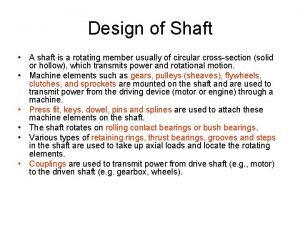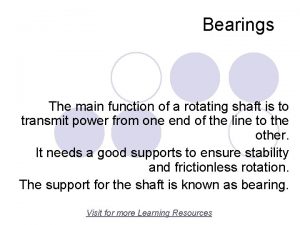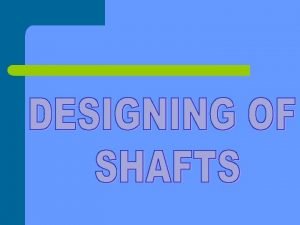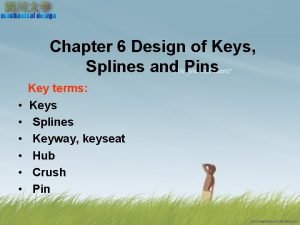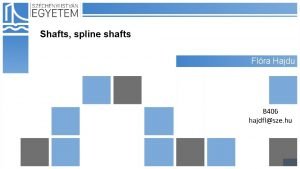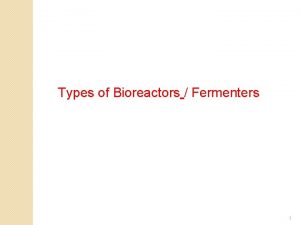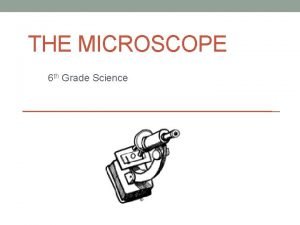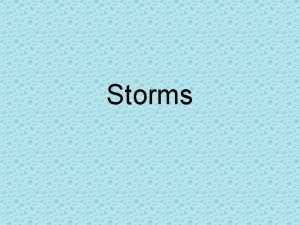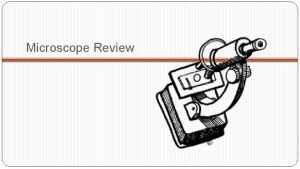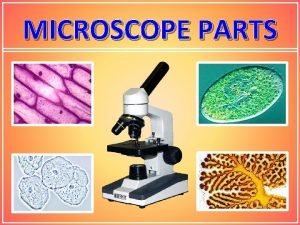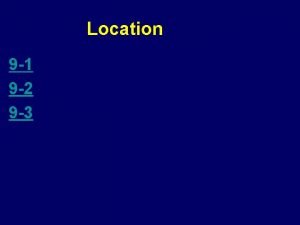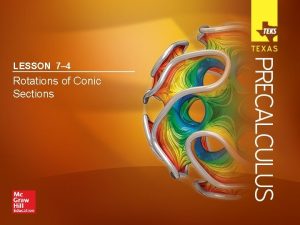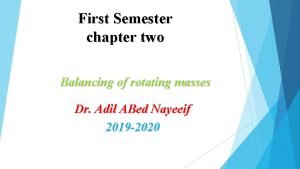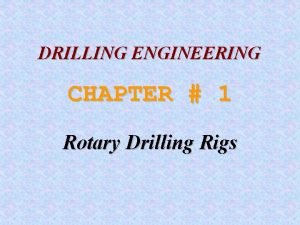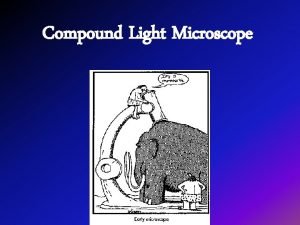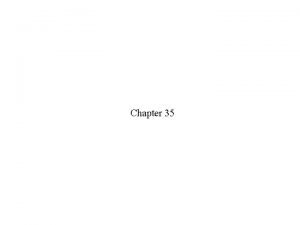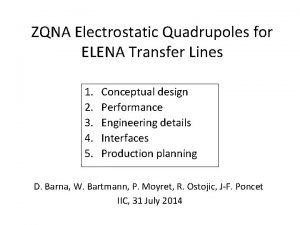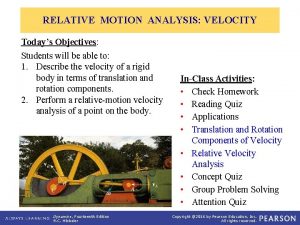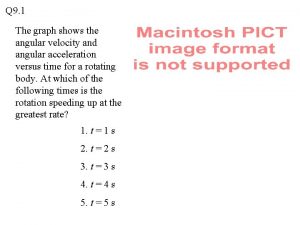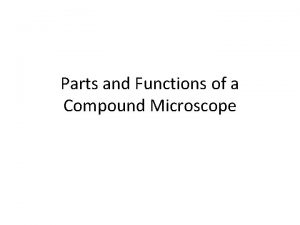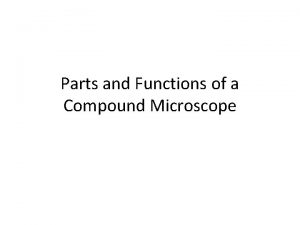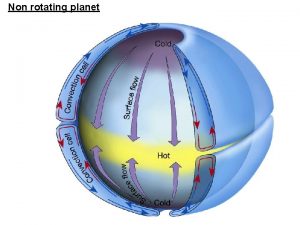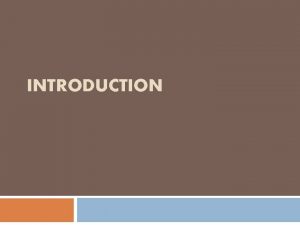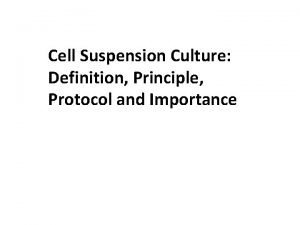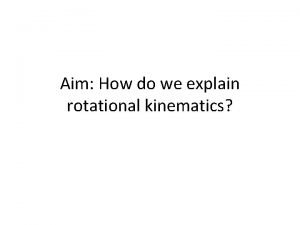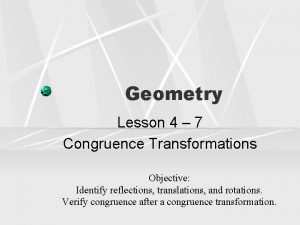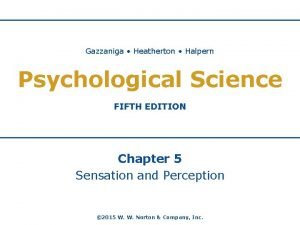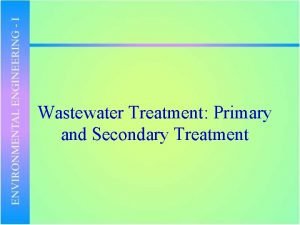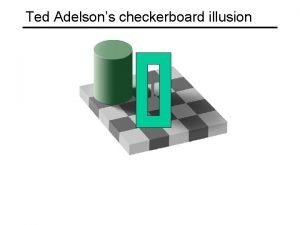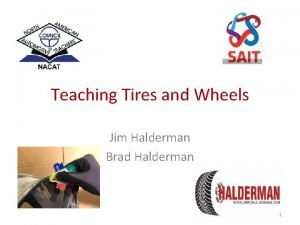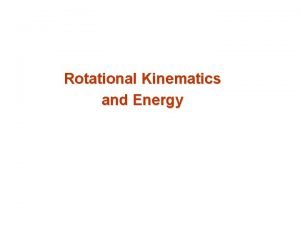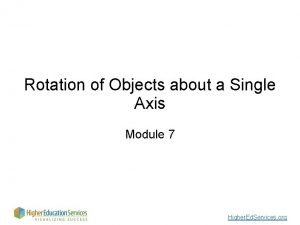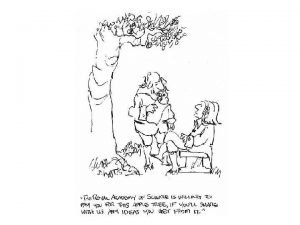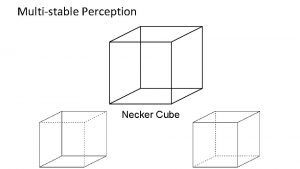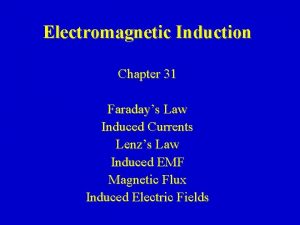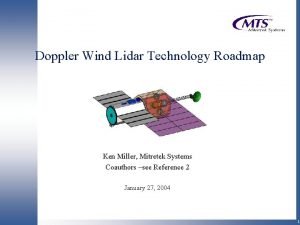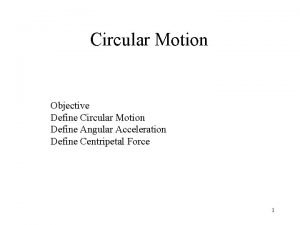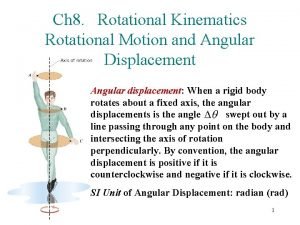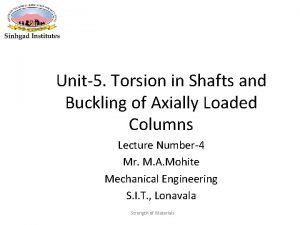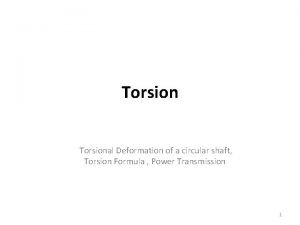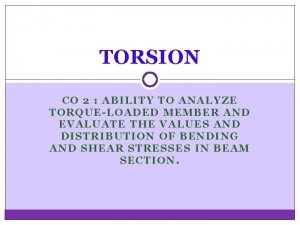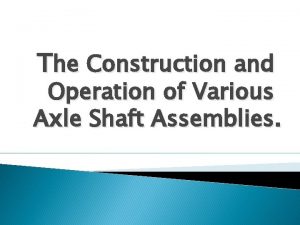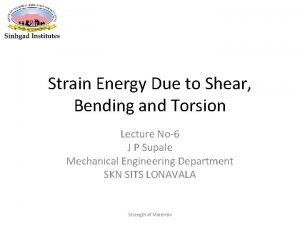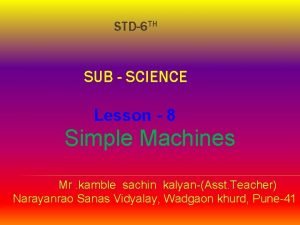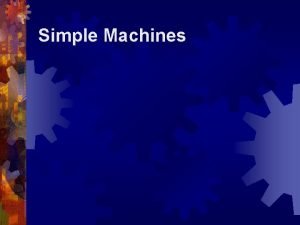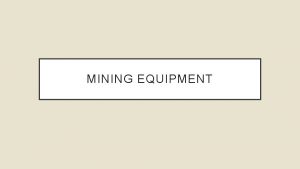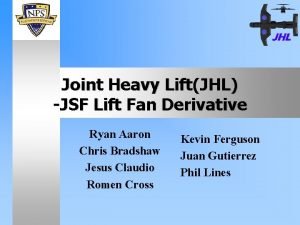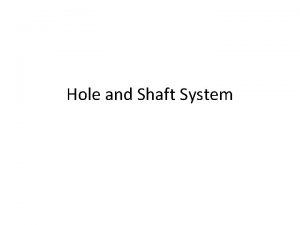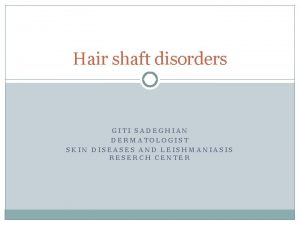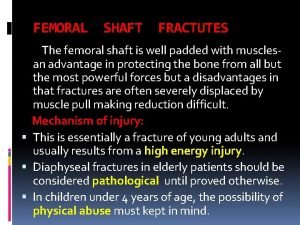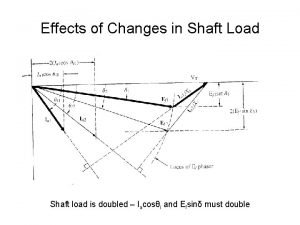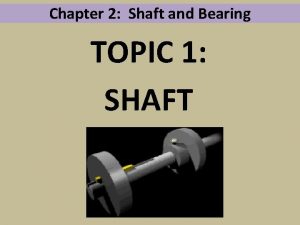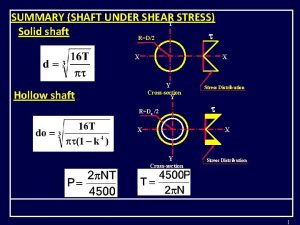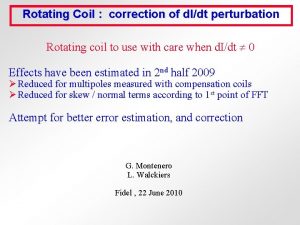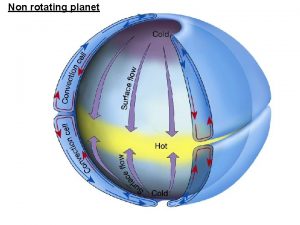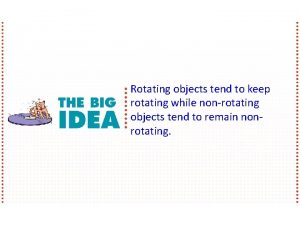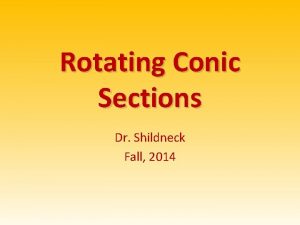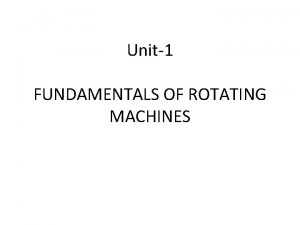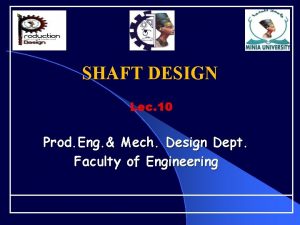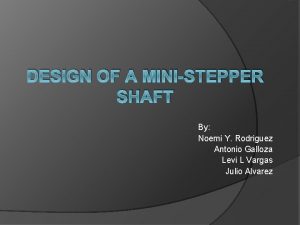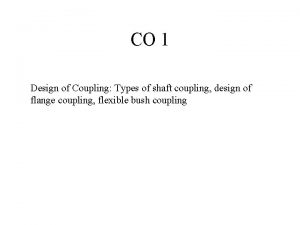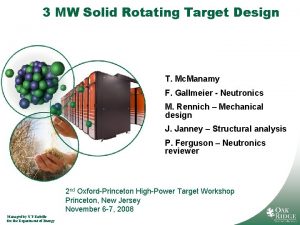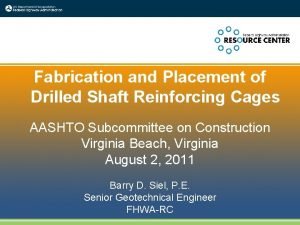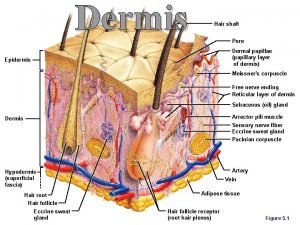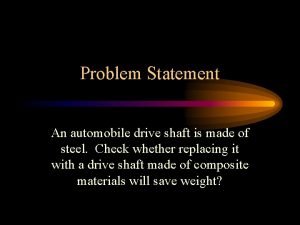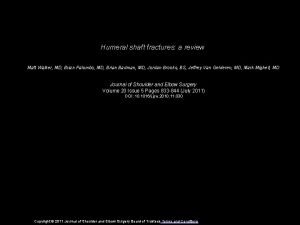Design of Shaft A shaft is a rotating





















































- Slides: 53

Design of Shaft • A shaft is a rotating member usually of circular cross-section (solid or hollow), which transmits power and rotational motion. • Machine elements such as gears, pulleys (sheaves), flywheels, clutches, and sprockets are mounted on the shaft and are used to transmit power from the driving device (motor or engine) through a machine. • Press fit, keys, dowel, pins and splines are used to attach these machine elements on the shaft. • The shaft rotates on rolling contact bearings or bush bearings. • Various types of retaining rings, thrust bearings, grooves and steps in the shaft are used to take up axial loads and locate the rotating elements. • Couplings are used to transmit power from drive shaft (e. g. , motor) to the driven shaft (e. g. gearbox, wheels). Visit for more Learning Resources

The connecting shaft is loaded primarily in torsion.

Combined bending and torsion loads on shaft: Shaft carrying gears. From power and rpm find the torque (T), which gives rise to shear stress. From Torque (T) and diameter (d), find Ft = 2 T/d. From Ft and pressure angles of gears you can find Fr and Fa. Fr and Ft are orthogonal to each other and are both transverse forces to the shaft axis, which will give rise to normal bending stress in the shaft. When shaft rotates, bending stress changes from tensile to compressive and then compressive to tensile, ie, completely reversing state of stress. Fa will give rise to normal axial stress in the shaft.

Loads on shaft due to pulleys Pulley torque (T) = Difference in belt tensions in the tight (t 1) and slack (t 2) sides of a pulley times the radius (r), ie T = (t 1 -t 2)xr Left pulley torque T 1 = (7200 -2700)x 380=1, 710, 000 N-mm Right pulley has exactly equal and opposite torque: T 2 = (6750 -2250)x 380=1, 710, 000 N-mm Bending forces in vertical (Fv) and horizontal (FH) directions: At the left pulley: FV 1=900 N; FH 1=7200+2700 = 9900 N At the right pulley: FV 2=900+6750+2250=9900 N; FH 2=0 FV 2

Torque and Bending moment diagrams for the pulley system 9900 N T 1 1, 710, 000 N-mm Torque diag. From Horizontal forces (FH) and vertical forces (Fv), Bending moments MH & MV are drawn separately. Then the resultant moments at various points on the shaft can be found from FH T 2 2, 227, 500 MH 9900 N FV 911, 250 MV 2, 227, 500 The section of shaft where the left pulley is located has obviously the highest combination of Torque (1, 710, 000 N-mm) and Bending moment (2, 406, 685 N-mm) 2, 227, 500 2, 406, 685 Resultant bending moment

Power, toque & speed For linear motion: Power = F. v (force x velocity) For rotational motion Power P = Torque x angular velocity = T (in-lb). w (rad/sec) in-lb/sec = T. (2 p n/60) in-lb/sec [n=rpm] = T. (2 p n/(60*12*550)) HP [HP=550 ft-lb/sec] = T. n/63, 025 HP or, T= 63, 025 HP/n (in-lb), where n = rpm Similarly, T= 9, 550, 000 k. W/n (N-mm), where n = rpm

Shear (t) and bending (s) stresses on the outer surface of a shaft, for a torque (T) and bending moment (M) For solid circular section: For hollow circular section:

Principal Normal Stresses and Max Distortion Energy Failure criterion for non-rotating shafts The stress at a point on the shaft is normal stress (s) in X direction and shear stress (t) in XY plane. From Mohr Circle: Max Distortion Energy theory: Putting values of S 1 & S 2 and simplifying: This is the design equation for non rotating shaft

Design of rotating shafts and fatigue consideration The most frequently encountered stress situation for a rotating shaft is to have completely reversed bending and steady torsional stress. In other situations, a shaft may have a reversed torsional stress along with reversed bending stress. The most generalized situation the rotating shaft may have both steady and cyclic components of bending stress (sav, sr) and torsional stress (tav, tr). From Soderberg’s fatigue criterion, the equivalent static bending and torsional stresses are: Using these equivalent static stresses in our static design equation, the equation for rotating shaft is:

Bearing mounting considerations and stress concentration

Conventional retaining (or snap) rings fit in grooves and take axial load, but groves cause stress concentration in shaft Retaining rings are standardized items, available in various standard sizes with various axial load capacities.

Push type retaining rings – no grooves required, less stress concentration, but less axial support

Various types of keys for transmitting torque

Other common types of keys

Various types of collar pins

Integrated splines in hubs and shafts allow axial motion and transmits torque All keys, pins and splines give rise to stress concentration in the hub and shaft

Chapter 11 - Keys, Couplings and Seals 11. 1 Chapter Objectives: • How attach power transmission components to shaft to prevent rotation and axial motion? Torque resistance: keys, splines, pins, weld, press fit, etc. . Axial positioning: retaining rings, locking collars, shoulders machined into shaft, etc…. • What is the purpose of rigid and flexible couplings in a power transmission system? • Specify seals for shafts and other types of machine elements.

11. 2 Keys Most common for shafts up to 6. 5” is the square and rectangular keys: Advantages: 1. Cost effective means of locking the 2. Can replace damaged component 3. Ease of installation 4. Can use key as “ fuse” – fails in shear at some predetermined torque to avoid damaging drive train. Figure 11. 1

Square and rectangular keys: Step 1 – Determine key size based on shaft diameter Step 2 – Calculate required length, L, based on torque (11. 4)

Step 3 – Specify appropriate shaft and bore dimensions for keyseat: See Figure 11. 2 For 5/16” key SHAFT BORE Note, should also specify fillet radii and key chamfers – see Table 11 -2

http: //www. driv-lok. com

Other types of keys: a. Tapered key – can install after hub (gear) is installed over shaft. b. Gib head key – ease of extraction c. Pin keys – low stress concentration d. Woodruff key – light loading offers ease of assembly

11. 4 Design of Keys – stress analysis to determine required length: = No load Torque being transmitted T = F/(D/2) or F = T/(D/2) this is the force the key must react!!!

Bearing stress Shear stress Required Length based on Shear Stress: Required Length based on Bearing Stress: Typical parameters for keys: N = 3, material 1020 CD (Sy = 21, 000 psi)

Example: Specify the complete key geometry and material for an application requiring a gear (AISI OQT 1000) with a 4” hub to be mounted to a 3. 6” diameter shaft (AISI 1040 CD). The torque delivered through the system is 21, 000 lb-in. Assume the key material is 1020 CD (Sy = 21, 000 psi) and N = 3. Solution (note since key is weakest material, focus analysis on key!): See handout

11. 4 Splines Advantages: • Can carry higher torque for given diameter (vs keys) or • Lower stress on attachment (gear) • Better fit, less vibration (spline integral to shaft so no vibrating key) • May allow axial motion while reacting torque Disadvantage: • Cost • Impractical to use as fuse

Splines “ Axial keys” machined into a shaft Transmit torque from shaft to another machine element

Advantages • Uniform transfer of torque • Lower loading on elements • No relative motion between “key” and shaft • Axial motion can be accommodated (can cause fretting and corrosion) • Mating element can be indexed with a spline • Generally hardened to resist wear

Spline Types • Straight – SAE – 4, 6, 10 or 16 splines • Involute – Pressure angles of 30, 37. 5, or 45 deg. – Tend to center shafts for better concentricity

SAE Spline Sizes A: Permanent Fit B: Slide without Load C: Slide under Load Pg 504

Two types of splines: Straight Sided Involute:

Use this for spline design – SAE formulas based on 1, 000 psi bearing stress allowable!! Use this to get diameter. Then table 11. 4 to get W, h, d

Torque Capacity • Torque capacity is based on 1000 psi bearing stress on the sides of the splines T = 1000*N*R*h N = number of splines R = mean radius of the splines h = depth of the splines

Torque Capacity Cont’d Substituting R and h into torque equation:

Torque Capacity Cont’d • Further refinement can be done by substituting appropriate values for N and d. • For 16 spline version, with C fit, N = 16 and d =. 810 D Torque in IN-LBS/INCH of spline Required D for given Torque

Torque Capacity for Straight Splines Pg 505

Torque Capacity for Straight Splines

Example: A chain sprocket delivers 4076 inlbs of torque to a shaft having a 2. 50 inch diameter. The sprocket has a 3. 25 inch hub length. Specify a suitable spline having a B fit. T = k. D 2 L T = torque capacity in in-lbs k. D 2 = torque capacity per inch (from Table 11 -5) L = length of spline in inches

Example Continued • From Table 11 -5, use 6 splines

Torque Capacity for Straight Splines 2. 5 4076/3. 25

Example: Specify straight spline for the previous problem (i. e. Torque = 21, 000 lb -in and shaft is 3. 6 in diameter.

Taper & Screw Expensive – machining Good concentricity Moderate torque capacity Can use a key too

Couplings • Used to connect two shafts together at their ends to transmit torque from one to the other. • Two kinds of couplings: – RIGID – FLEXIBLE

Rigid Couplings NO relative motion between the shafts. Precise alignment of the shafts Bolts in carry torque in shear. N = # of bolts.

Flexible Couplings • Transmit torque smoothly • Permit some axial, radial and angular misalignment

Flexible Couplings

Flexible Couplings

Lord Corp. Products

Flexible Coupling

Universal Joints Large shaft misalignments permissible Key factors in selection are Torque, Angular Speed and the Operating Angle Output not uniform wrt input Output IS uniform wrt input

Axial Constraint Methods Spacers Retaining ring Shoulders

Retaining Rings

Locknuts For more detail contact us
 Design of shaft formula
Design of shaft formula What is function of bearing
What is function of bearing Shaft is design on the basis of
Shaft is design on the basis of Design of keys
Design of keys Spline shaft technical drawing
Spline shaft technical drawing Rotating drum fermenter
Rotating drum fermenter Coarse adjustment knob
Coarse adjustment knob Large scale rotating air mass
Large scale rotating air mass Eyepiece microscope
Eyepiece microscope Light microscope parts
Light microscope parts Fearth
Fearth Rotating conic sections
Rotating conic sections Balancing of several masses rotating in the same plane
Balancing of several masses rotating in the same plane Hoisting system components
Hoisting system components Microscope body parts
Microscope body parts Instantaneous value of the emf phasor
Instantaneous value of the emf phasor Rotating flanges
Rotating flanges Relative motion analysis using rotating axes
Relative motion analysis using rotating axes Compared to a gear tooth on the rear sprocket
Compared to a gear tooth on the rear sprocket Function of draw tube in microscope
Function of draw tube in microscope Microscope dust shield
Microscope dust shield Non rotating planet
Non rotating planet Rotating disc where the objectives are attached
Rotating disc where the objectives are attached Slowly rotating culture
Slowly rotating culture Different axial and locomotor movements
Different axial and locomotor movements A disk initially rotating at 120 rad/s
A disk initially rotating at 120 rad/s Rotating cube display
Rotating cube display The operation that maps or moves a preimage onto an image
The operation that maps or moves a preimage onto an image Psychological science 5th edition
Psychological science 5th edition Where can we find rotating arm sprays in sewage treatment?
Where can we find rotating arm sprays in sewage treatment? Adelson's checkerboard
Adelson's checkerboard 4x4 tire rotation
4x4 tire rotation A rotating wheel requires 3 seconds
A rotating wheel requires 3 seconds Horizontal axis rotating modules
Horizontal axis rotating modules Rotating coordinate systems
Rotating coordinate systems Rigid body transformation in computer graphics
Rigid body transformation in computer graphics Spinning dancer illusion gif
Spinning dancer illusion gif Frcr physics lectures
Frcr physics lectures Faraday's law is
Faraday's law is Rotating lidar
Rotating lidar This yes
This yes Circular motion
Circular motion The blade of a lawn mower is rotating at an angular
The blade of a lawn mower is rotating at an angular Slenderness ratio formula
Slenderness ratio formula Circular shaft formula
Circular shaft formula Angle of twist sign convention
Angle of twist sign convention Working of axle
Working of axle Strain energy due to axial load
Strain energy due to axial load Blank is an inclined plane wrapped in a cylindrical post
Blank is an inclined plane wrapped in a cylindrical post Simple machines in a bike
Simple machines in a bike Shaft mining equipment
Shaft mining equipment Lift fan drive shaft
Lift fan drive shaft 8f7 tolerance
8f7 tolerance Pili annulati
Pili annulati
